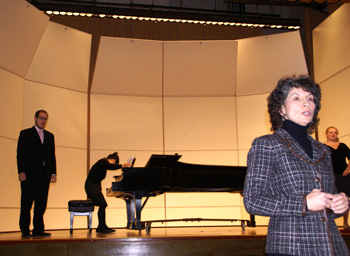|
|
Bringing an opera production to life is a great challenge. Marrying a dramatic work with a musical score to create a moving work of art requires collaboration on many levels by many individuals.
The challenge has been taken up a notch this year at the State University of New York at Fredonia as the Hillman Opera mounts its largest total production ever with Giacomo Puccini’s “La Bohème.”
The opera opens on Thursday, Nov. 12 and runs through Sunday, Nov. 15 in Marvel Theatre at Rockefeller Arts Center on the SUNY Fredonia campus.
Some behind-the-scenes insight into this year’s production was offered as an Arts and Humanities Brown Bag Lecture Series presented by SUNY Fredonia on Nov. 4.
Taking part in the presentation were Hillman Opera Producer Julie Newell and Music Director Dr. David Rudge, both of the School of Music, and Stage Director Tom Loughlin and Technical Advisor Stephen Rees, both of the Department of Theatre and Dance. Their panel discussion was entitled “Putting It Together: The Art and Scholarship of Staging La Bohème.”
Ms. Newell explained the opera is an annual tradition started more than 50 years ago by the Hillman Music Association.
“It’s one of the highlights of the academic year,” she said. “It’s particularly exciting this year because it will be the largest total production we have ever done.”
In addition to a grand musical score, “La Bohème” features a massive set, a children’s chorus, a marching band and performances by two alumni singers – Jennifer Winn and Erik Angerhofer – who are now opera professionals.
Because there are so many layers involved in a production like this, collaboration is the key to making it all work. Dr. Rudge explained that his role as music director is to “unify all the pieces in the end.” That point arrives after many hours of preparation by many people.
“The collaboration is based on trust,” Dr. Rudge said. “There are so many things to bring together.”
Mr. Rees said the ability to work together is a strong point for School of Music and Department of Theatre and Dance.
“We do that pretty well here,” he said. “We have that collaborative process worked out.”
That process is put to the test in an opera, where the music and the acting have to come together in just the right blend. Mr. Loughlin explained one of the keys is for the actor-singers to learn to react to the structure if the music.
“When you’re talking about a Puccini piece like ‘La Bohème,’ you have to look at the structure of the music,” he said. “The structure of the music tells the actors-singers what to do.”
At the same time, Dr. Rudge said the “acting makes the music.”
“That’s what’s so amazing about opera,” he said. “The result is so emotionally amazing.”
While a bond is being built between actor and musician, another more literal building process takes place – the construction of the set. For “La Bohème,” there are three different set locations, including one with an impressive two-story piece.
Mr. Rees said the set is rented from Tri-Cities Opera Company Inc. of Binghamton. It arrived at SUNY Fredonia via a 53-foot long truck on Nov. 4, a massive collection of pieces which had to be assembled over a 12-hour period.
“I think of myself more as a mechanic,” Mr. Rees said. “I don’t know what I have to work with until it shows up on the loading dock.”
Ms. Newell said the groundwork will have been well laid by the time audiences see “La Bohème.”
“When you come to see it, it will be a beautiful thing to your ears and your eyes,” she said.
Performance times are 8 p.m. on Nov. 12, 13 and 14 and 2 p.m. on Nov. 15. Tickets are available through the SUNY Fredonia Ticket Office in the Williams Center, by phone at 716-673-3501 (1-866-441-4928) and online at www.fredonia.edu/tickets.




